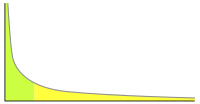
Photo from wikipedia
BACKGROUND AND OBJECTIVE Levodopa-induced dyskinesia (LID) is a disabling complication of Parkinson's disease (PD). Imaging-based measurements, especially those related to the surface shape of the basal ganglia, have shown potential… Click to show full abstract
BACKGROUND AND OBJECTIVE Levodopa-induced dyskinesia (LID) is a disabling complication of Parkinson's disease (PD). Imaging-based measurements, especially those related to the surface shape of the basal ganglia, have shown potential for explaining the severity of LID in PD. Here, we aimed to explore a novel application of the methodology to find biomarkers of LID severity in PD using regularization. METHODS We proposed an application of graph-constrained elastic net (GraphNet) regularization to detect surface-based shape biomarkers explaining the severity of LID and compared the approach with other conventional regularization methods. To examine the methods, we used two independent datasets, one as a training dataset to build the model, and the other dataset was used to validate the constructed model. RESULTS We found that the left striatum (putamen was the greatest and the caudate was second) was the most significant surface-based biomarker related to the severity of LID. Our results improved the interpretability of identified surface-based biomarkers compared to competing methods. We also found that GraphNet regularization improved prediction of the severity of LID better than the conventional regularization methods. Our model performed better in terms of root-mean-squared error and correlation coefficient between predicted and actual clinical scores. CONCLUSION The proposed algorithm offers an advantage of interpretable anatomical variations related to the deformation of the cortical surface. The experimental results showed that GraphNet regularization was robust to identify surface-based shape biomarkers related to both hypokinetic and hyperkinetic movement disorders.
Journal Title: Computer methods and programs in biomedicine
Year Published: 2020
Link to full text (if available)
Share on Social Media: Sign Up to like & get
recommendations!